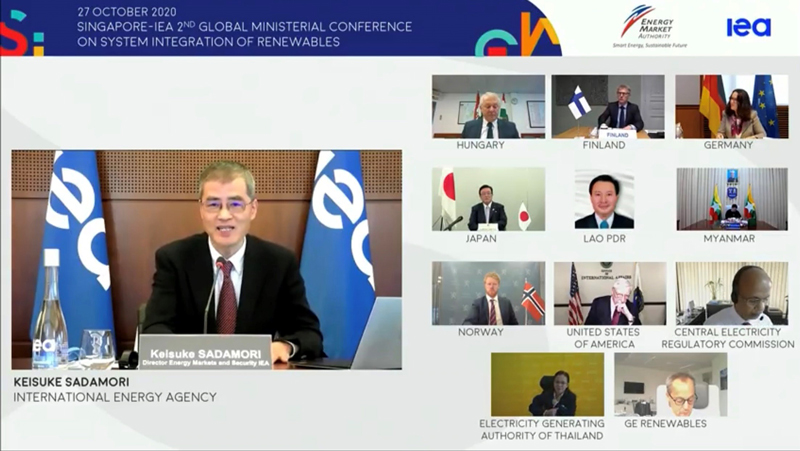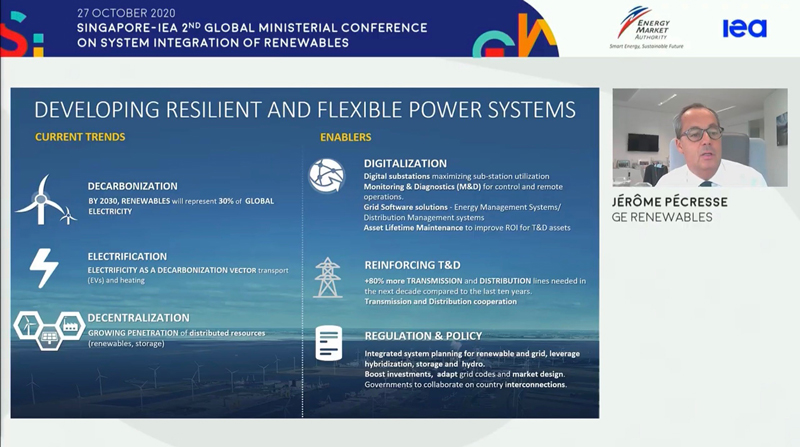The International Energy Agency (IEA) led a wide-ranging panel discussion on the critical role of enhancing resilience and flexibility in our power systems to support the integration of renewable energy sources. By Weijian.

The impact of the global pandemic on power systems underscored the importance of a stable energy supply. The intermittency of renewable energy sources also needs to be managed by better supporting infrastructure like the grid, energy storage systems and smart meters.
This discussion took centre stage during the second session of the 2nd Global Ministerial Conference on System Integration of Renewables, moderated by Mr Keisuke Sadamori, Director (Energy Markets and Security) of IEA.
Panellists shared their insights on the key steps to ensure electricity grids remain resilient and flexible, and discussed the evolving role of digitalisation in the future of clean energy systems.
First, higher investments in the transmission network would be necessary. In this regard, H.E. Elisabeth Winkelmeier-Becker, Parliamentary State Secretary of the Ministry for Economic Affairs and Energy, Germany, shared that the German grid needs to be expanded by about 10,000 kilometres of reinforced or new lines to support connectivity of renewable energy sources.
Jérôme Pécresse, Chief Executive Officer of GE Renewables, estimated that 80% more transmission and distribution lines are needed in the next decade compared to the last.

Second, each country’s energy mix can be managed more effectively to ensure a continuous stable supply. For the USA, H.E. Theodore J. Garrish, Assistant Secretary for Office of International Affairs, Department of Energy, shared that baseload power must be adequately compensated in order to ensure that peak demand can be met during periods of lower supply from renewable sources.
Similarly, India plans to make its predominantly coal-based supply more flexible, said Shri P.K. Pujari, Chairman of the Central Electricity Regulatory Commission of India.
H.E. Tony Christian Tiller, State Secretary of the Ministry of Petroleum and Energy, Norway, shared that while it has a resilient and stable supply of hydropower, it is strongly dependent on weather and climate conditions. Norway therefore also relies on interconnectors with other countries as a key strategy to increase flexibility and security of supply.
With its abundant hydropower supply, Lao PDR is also looking at the possibility of using the surplus energy to produce and store as green hydrogen. This was shared by H.E. Sinava Souphanouvong, Deputy Minister of Energy and Mines.
Third, digitalisation helps to ensure grid stabilisation and optimisation, as shared by H.E. U Khin Maung Win, Deputy Minister for Electricity and Energy, Myanmar.
With greater digitalisation, there is also a greater emphasis placed on cybersecurity’s importance. H.E. Dr Péter Kaderják, Minister of State of the Ministry of Energy and Climate Affairs, Hungary, said that this could be government financed, alongside grid upgrades for enhanced flexibility.
H.E. Kimmo Tiilikainen, State Secretary of the Ministry of Economic Affairs and Employment, Finland, added that there should be sharing of best practices in a close public-private corporate to ensure cybersecurity is taken care of.
Finally, a comprehensive national energy development plan and updated regulations will help to accelerate renewable energy integration. For example, Dr Jiraporn Sirikum, Deputy Governor – Strategy of the Electricity Generating Authority, Thailand explained that the Thai Power Development Plan 2018 considered the deployment of alternative energy and improving energy efficiency, alongside traditional considerations of energy security and competitiveness.
H.E. Yasumasa Nagasaka, State Minister of the Ministry of Economy, Trade and Industry, Japan, added that they are reviewing rules on access to the grid—as it is currently on a first-come-first-served basis which prioritises coal-fired generation that was connected earlier.
Follow us on Twitter (@SIEW_sg) to get the latest #SIEW2020 updates.